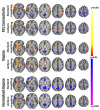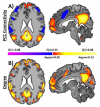The impact of image smoothness on intrinsic functional connectivity and head motion confounds
- PMID: 24657356
- PMCID: PMC4076413
- DOI: 10.1016/j.neuroimage.2014.03.035
The impact of image smoothness on intrinsic functional connectivity and head motion confounds
Abstract
We present a novel method for controlling the effects of group differences in motion on functional connectivity studies. Resting-state functional magnetic resonance imaging (rs-fMRI) is a powerful tool that allows for the assessment of whole-brain functional organization across a wide range of clinical populations. However, as highlighted by recent studies, many measures commonly used in rs-fMRI are highly correlated with subject head movement. A source of this problem is that motion itself, and motion correction algorithms, lead to spatial smoothing, which is then variable across the brain and across subjects or groups dependent upon the amount of motion present during scanning. Studies aimed at elucidating differences between populations that have different head-motion characteristics (e.g., patients often move more in the scanner than healthy control subjects) are significantly confounded by these effects. In this work, we propose a solution to this problem, uniform smoothing, which ensures that all subject images in a study have equal effective spatial resolution. We establish that differences in the intrinsic smoothness of images across a group can confound connectivity results and link these differences in smoothness to motion. We demonstrate that eliminating these smoothness differences via our uniform smoothing solution is successful in reducing confounds related to the differences in head motion between subjects.
Keywords: Connectivity; Head movement; Image smoothness; Motion; Resting-state fMRI.
Copyright © 2014 Elsevier Inc. All rights reserved.
Figures








Similar articles
-
Head Motion and Correction Methods in Resting-state Functional MRI.Magn Reson Med Sci. 2016;15(2):178-86. doi: 10.2463/mrms.rev.2015-0060. Epub 2015 Dec 22. Magn Reson Med Sci. 2016. PMID: 26701695 Free PMC article. Review.
-
Combining Prospective Acquisition CorrEction (PACE) with retrospective correction to reduce motion artifacts in resting state fMRI data.Brain Behav. 2019 Aug;9(8):e01341. doi: 10.1002/brb3.1341. Epub 2019 Jul 11. Brain Behav. 2019. PMID: 31297966 Free PMC article.
-
A wavelet method for modeling and despiking motion artifacts from resting-state fMRI time series.Neuroimage. 2014 Jul 15;95(100):287-304. doi: 10.1016/j.neuroimage.2014.03.012. Epub 2014 Mar 21. Neuroimage. 2014. PMID: 24657353 Free PMC article.
-
An evaluation of the efficacy, reliability, and sensitivity of motion correction strategies for resting-state functional MRI.Neuroimage. 2018 May 1;171:415-436. doi: 10.1016/j.neuroimage.2017.12.073. Epub 2017 Dec 24. Neuroimage. 2018. PMID: 29278773
-
Resting State fMRI: Going Through the Motions.Front Neurosci. 2019 Aug 13;13:825. doi: 10.3389/fnins.2019.00825. eCollection 2019. Front Neurosci. 2019. PMID: 31456656 Free PMC article. Review.
Cited by
-
Cluster failure or power failure? Evaluating sensitivity in cluster-level inference.Neuroimage. 2020 Apr 1;209:116468. doi: 10.1016/j.neuroimage.2019.116468. Epub 2019 Dec 15. Neuroimage. 2020. PMID: 31852625 Free PMC article.
-
Cerebellar and prefrontal cortical alterations in PTSD: structural and functional evidence.Chronic Stress (Thousand Oaks). 2018 Jan-Dec;2:2470547018786390. doi: 10.1177/2470547018786390. Epub 2018 Jul 6. Chronic Stress (Thousand Oaks). 2018. PMID: 30035247 Free PMC article.
-
Head Motion and Correction Methods in Resting-state Functional MRI.Magn Reson Med Sci. 2016;15(2):178-86. doi: 10.2463/mrms.rev.2015-0060. Epub 2015 Dec 22. Magn Reson Med Sci. 2016. PMID: 26701695 Free PMC article. Review.
-
Cingulate cortex functional connectivity predicts future relapse in alcohol dependent individuals.Neuroimage Clin. 2016 Nov 1;13:181-187. doi: 10.1016/j.nicl.2016.10.019. eCollection 2017. Neuroimage Clin. 2016. PMID: 27981033 Free PMC article.
-
Motion artifact in studies of functional connectivity: Characteristics and mitigation strategies.Hum Brain Mapp. 2019 May;40(7):2033-2051. doi: 10.1002/hbm.23665. Epub 2017 Nov 1. Hum Brain Mapp. 2019. PMID: 29091315 Free PMC article. Review.
References
-
- Biswal B, Zerrin Yetkin F, Haughton VM, Hyde JS. Functional connectivity in the motor cortex of resting human brain using echo-planar mri. Magnetic Resonance in Medicine. 1995;34:537–541. - PubMed
-
- Biswal BB, Mennes M, Zuo XN, Gohel S, Kelly C, Smith SM, Beckmann CF, Adelstein JS, Buckner RL, Colcombe S, Dogonowski AM, Ernst M, Fair D, Hampson M, Hoptman MJ, Hyde JS, Kiviniemi VJ, Kötter R, Li SJ, Lin CP, Lowe MJ, Mackay C, Madden DJ, Madsen KH, Margulies DS, Mayberg HS, McMahon K, Monk CS, Mostofsky SH, Nagel BJ, Pekar JJ, Peltier SJ, Petersen SE, Riedl V, Rombouts SA, Rypma B, Schlaggar BL, Schmidt S, Seidler RD, Siegle GJ, Sorg C, Teng GJ, Veijola J, Villringer A, Walter M, Wang L, Weng XC, Whitfield-Gabrieli S, Williamson P, Windischberger C, Zang YF, Zhang HY, Castellanos FX, Milham MP. Toward discovery science of human brain function. Proc Natl Acad Sci U S A. 2010;107:4734–4739. - PMC - PubMed
-
- Buckner RL, Sepulcre J, Talukdar T, Krienen FM, Liu H, Hedden T, Andrews-Hanna JR, Sperling RA, Johnson KA. Cortical Hubs Revealed by Intrinsic Functional Connectivity: Mapping, Assessment of Stability, and Relation to Alzheimer’s Disease. The Journal of Neuroscience. 2009;29:1860–1873. - PMC - PubMed
-
- Cole MW, Pathak S, Schneider W. Identifying the brain’s most globally connected regions. NeuroImage. 2010;49:3132–3148. - PubMed
Publication types
MeSH terms
Grants and funding
LinkOut - more resources
Full Text Sources
Other Literature Sources

